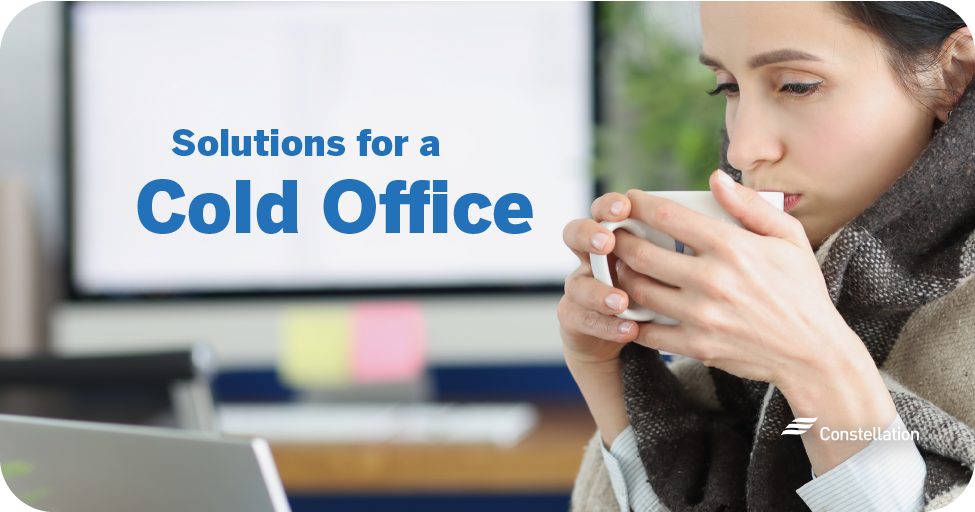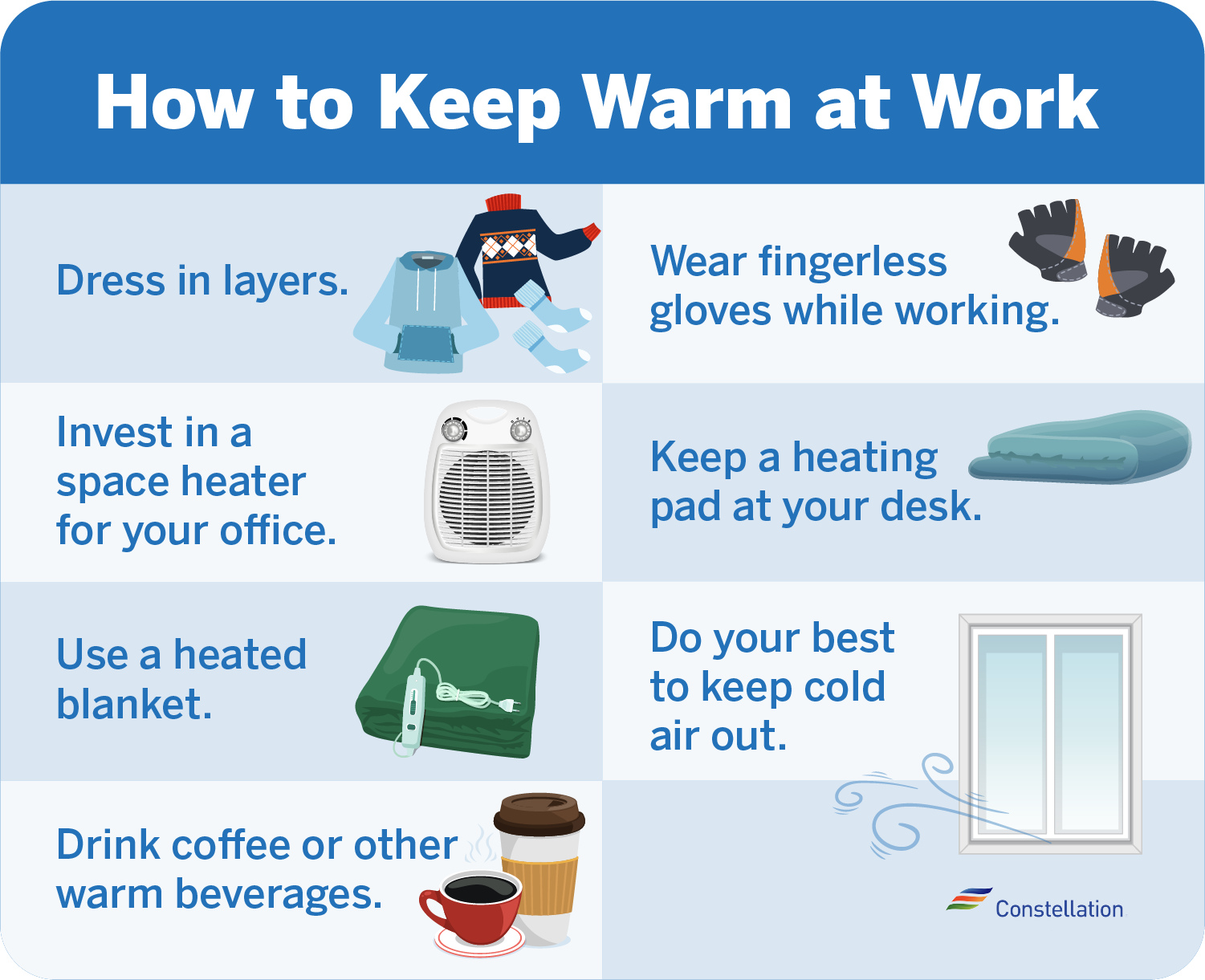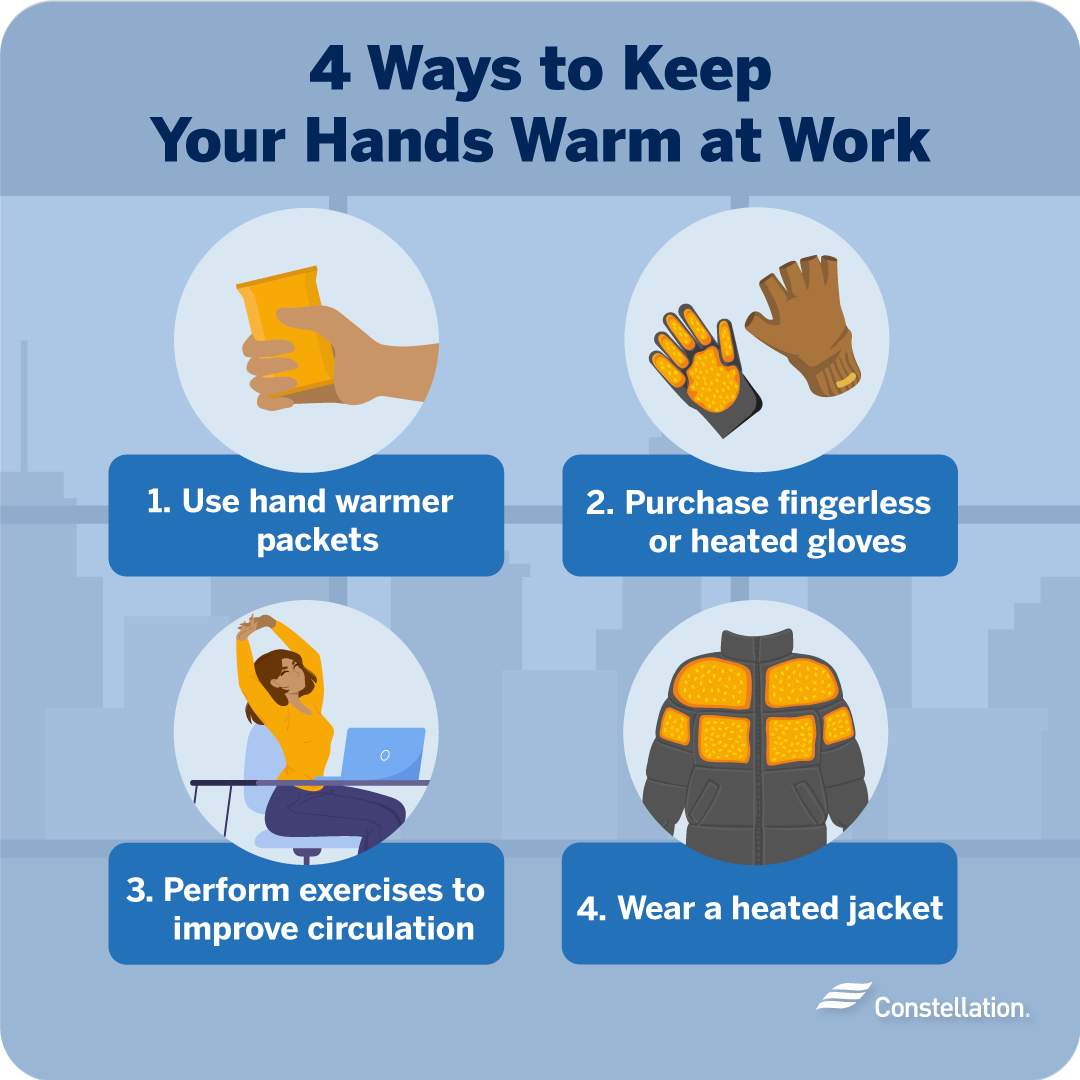
- Category:
Small Business Energy Savings -
Last updated:
December 22, 2023
How to Stay Warm in a Cold Office
As winter weather sets in, working out how to stay warm in a cold office does more than improve morale and productivity, it can keep your heating bill under control.
Here are tips for how to stay warm at work. Some employees are more sensitive to being cold in the office. You won’t find a temperature that suits everyone, but we share ways to accommodate everyone.
Jump to section:
- 10 ways to keep warm at work
- Why are offices so cold?
- How cold is too cold for an office?
- Is it healthy to work in a cold office?
- Can employees refuse to work in cold conditions?
- Creating a comfortable office environment
10 ways to keep warm at work
After you have implemented cold office solutions and achieved a temperature that is optimal to most people, some employees may still feel cold. Here are some suggestions that will help them feel less chilly at work.

1. Dress in layers
One of the best ideas for how to stay warm in a cold office is to wear several lighter weight items on top of each other. Several items worn in layers traps warmth. If the day warms up, you can remove a layer. As it gets later and colder, you can put on the layers again.
What should I wear to stay warm in a cold office?
- Insulated base layers. These are articles you wear directly on your skin. They should wick moisture away from your body. Cotton is a poor base layer, as it retains moisture, which can result in a chill later.
- Warm socks. If your feet are cold, your whole body feels cold. Wool socks or wool blend socks–again, no cotton–will retain body heat.
- Closed toe shoes. Wear comfortable shoes that cover your feet, such as felt slippers or booties, to avoid being chilly at work.
- Sweater or jacket. As a middle or outer layer, these items add considerable warmth and are easy to take off during the day.
- Hat and scarf. Because we lose so much heat through our heads and necks, adding a cap and a scarf or neck warmer can really help.
- Shawls. Bigger than a scarf, these larger wraps can almost feel like a cozy blanket. Wool and wool blends are best.
- Leg warmers. You might feel like you stepped onto the Flashdance set, but these 80’s accessories help keep your lower extremities warm. Like a sock open at the top and toe, slip these onto your lower legs and fight drafts.
2. Invest in a space heater for your office
When looking for how to stay warm at work, consider heating individual workspaces with small personal heaters. An energy-efficient space heater provides warmth to individual employees who prefer higher temperatures without affecting your small business energy consumption or forcing everyone else to work in higher temperatures.
3. Use a heated blanket
Even more energy-efficient than space heaters are heated blankets. Employees can wrap them over their shoulders or around their legs for a customized and cozy work environment. It is more efficient to heat your body than it is to heat the air around yourself. In addition to traditional plug-in models, you can find rechargeable battery-operated blankets that are extra energy efficient.
4. Drink coffee or other warm beverages
An effective way to raise your body temperature is to drink warm liquids. Buying a coffee maker for your business provides ready warmth to your staff. Many models include a hot water option for tea or soup. Offering nourishing warmth is a good way to show you care and definitely raises morale as it raises temperatures.
5. Wear fingerless gloves while working
Some people feel cold in their extremities, even when your office temperature is within the normal range. Your hands may feel cold even if you are wearing a sweater. Fingerless gloves give you the dexterity to type or perform other manual tasks, yet provide warmth where you need it the most.
Other ways to keep your hands warm at work

When it comes to how to stay warm in a cold office, you have many options.
- Use hand warmer packets. These inexpensive disposable packets use a chemical reaction to keep your hands warm for up to ten hours.
- Purchase heated gloves. Wear a pair of these, charged by a USB cable, as one of the great ways to keep your hands warm at work.
- Perform exercises to improve circulation. You can help warm your hands up at work by taking a movement break to raise your body temperature.
- Wear a heated jacket. Like heated gloves, these lightweight coats charge by USB. When your hands get cold, you can slip them into the sleeves to help keep them toasty.
6. Keep a heating pad at your desk
Your office temperature might be comfortable, but a cold and drafty floor can make your feet feel like ice. Keeping a heating pad under your workspace can warm your frozen toes. When your extremities are warm, you tend to feel warmer overall.
7. Do your best to keep cold air out
One of the most fundamental cold office solutions is stopping drafts.Check your insulation, especially around doors and windows. Adding seasonal vestibules around doors that open directly to the outside can stop blasts of cold air blowing in when anyone comes in or goes out. Add office etiquette signs around outside doors to remind people not to prop them open to let cold air in.
8. Upgrade to a heated keyboard and mouse
One of the newer ways to keep your hands warm at work is to use a heated keyboard, mouse or desk mat. They plug into power using a USB and heat your fingers as you work.
9. Stay hydrated to help regulate your body temperature
Your blood circulates more effectively when you are well-hydrated, which is key to feeling warm. In the cold, dry air of winter, it is easy to get dehydrated and not realize it.
10. Get up and move around when possible
When you get up and move, your heart rate increases, as does your blood circulation. Your muscles burn energy and create heat when you move. Both will raise your body temperature.
Why are offices so cold?
If you regularly feel cold in the office, you might wonder why are offices so cold. With people coming in and out of your business, you may be letting considerable cold air into your workplaces. Office buildings often have inadequate insulation. Businesses trying to reduce their carbon footprints may keep the thermostat a few degrees cooler.
How cold is too cold for an office?
How cold is too cold? The ideal office temperature is actually warmer than you might think. For years, experts recommended that the best thermostat settings were between 70 and 73 degrees Fahrenheit. More recent research, however, has shown that range to be too cold now that few of us wear a suit and tie to work.
Worker error rates dropped by 3% with each degree of warmth, up to an optimum of 77 degrees. If your office temperature is consistently below this number, it’s likely your office is too chilly for many of your employees. You’ll want to look into what to do when your office is too cold.
Is it healthy to work in a cold office?
In addition to asking why are offices so cold, you might wonder if a cold office can harm your health. If you and your team are exposed to extreme cold, you may be at risk of cold stress. It’s important to learn how to stay warm in a cold room. When your body is overwhelmed by the cold and can’t warm itself, you may develop serious conditions, like hypothermia, chilblains, trench foot and frostbite.
Can employees refuse to work in cold conditions?
Uncomfortable office temperatures consistently rank among the top employee office complaints. Extreme temperatures that affect employee well-being and safety can trigger OSHA filings and lawsuits.
One person’s comfort zone might feel like a deep freeze to another, so it is impossible to keep everyone happy or establish a standard. Unless you have a severe temperature problem in your office that puts employees in danger, employees do not have a right to refuse to work because they feel chilly.
That said, you don’t want employees grumbling. Finding effective cold office solutions will enhance morale and improve productivity.
Creating a comfortable office environment
While there’s no ideal temperature that will please everyone, your teams will get more done, commit fewer errors, and will be happier when they feel comfortable. Learn how to stay warm in a cold office and solve the root cause as to why offices are so cold in your place of business. You can keep your team comfortable and your heating bills lower.




